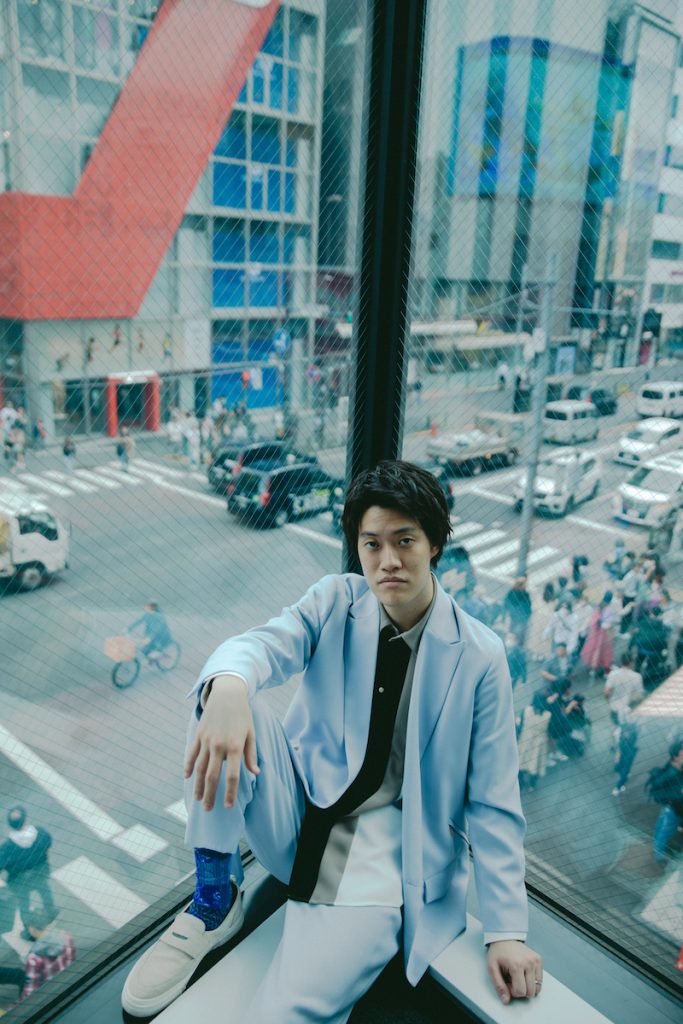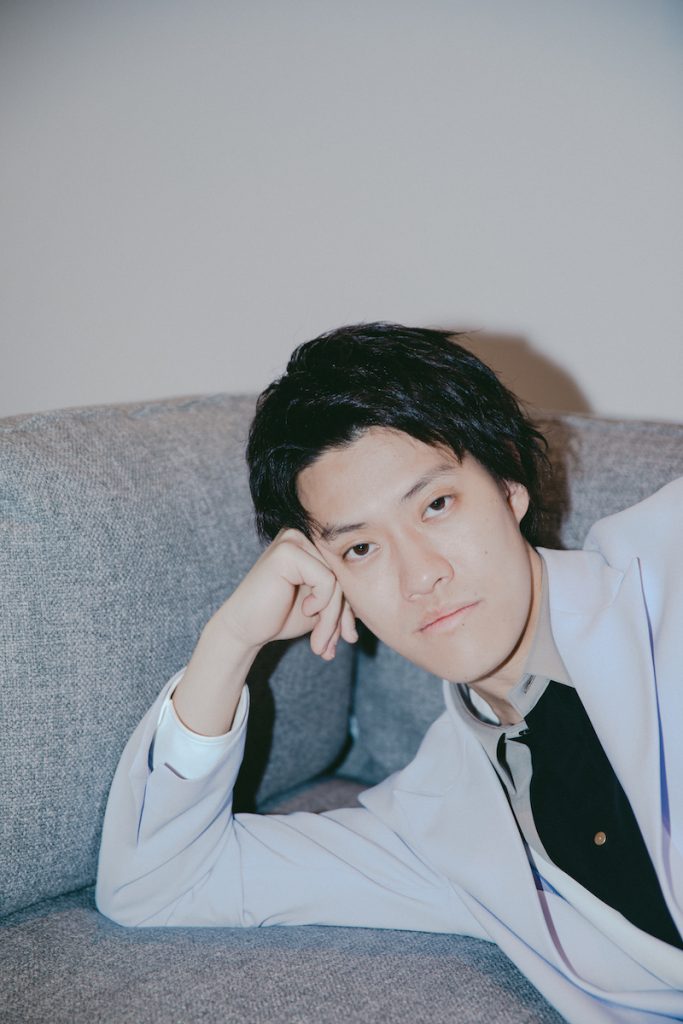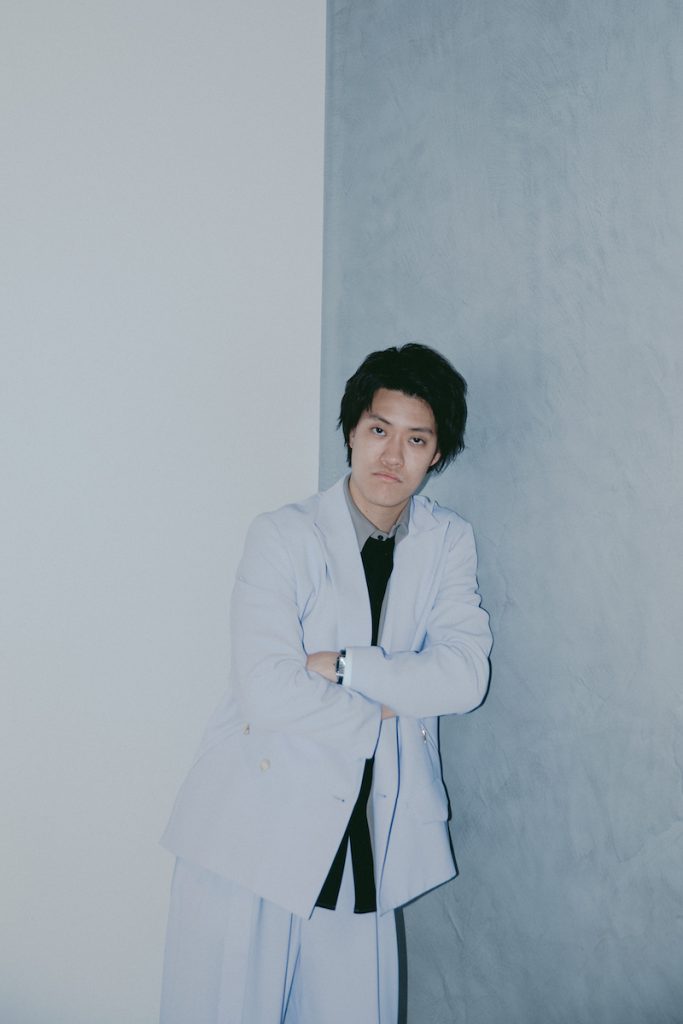
Soshina, a member of the comedy duo Shimofuri Myojo, is also producing music as an artist. “Yusari no Kanon feat. Yuika”, a song he composed as the ending theme of the anime Ao no Orchestra (which began airing on NHK E-television on April 9, 2023), attracted a great deal of attention on social media. We asked him about the secret stories behind the song’s creation, his passion for music, and his creative practices spanning different fields. Discover the source of his creativity at the intersection of music and comedy.
I would read scores of Blue Hearts and MTH like novels in my teens
–Please tell us how you came into contact with music.
Soshina: I started playing music when I was two years old. At first, I took piano lessons under the influence of my parents, and I spent a lot of time playing music. In middle school, I started to find the types of music I wanted to play by myself and started playing the guitar for that. Of course, there were times when I played with friends, but while everyone else devoted themselves to club activities, I was absorbed either in comedy or music. In high school, I had friends doing desktop music (DTM), so I started using it myself to produce songs. Back then, I loved using computers, and there was a lot of free software available so that I could get started smoothly.
— At that time, many people were composing songs to upload or uploading clips of themselves covering some music with the title “me singing~” on Nico Nico Douga, weren’t they?
Soshina: Those were good times. It was fun to compose music back then, all the more because of the conditions of the times.
— Are there any artists or music that influenced you in terms of how you compose your music?
Soshina: I have always listened to music I heard on the Internet, such as Vocaloid music and anime songs. Even now, I especially like Oishi Masayoshi, Tomoya Tabuchi, Hyadain, Hige Driver, and Tamaya 2060%. I was also influenced by the bands like Blue Hearts and Maximum the Hormone, which I listened to countless times when I was in elementary, middle, and high school. I bought band scores and read them all like novels.
— Many of your songs seem to be vocaloid-oriented, so I was surprised to hear the names of rock from you such as Blue Hearts and Maximum the Hormone. How do these link to your own music?
Soshina: I guess their simple chord progression. I don’t use complicated and emotional chords as much as the other producers do for their songs today. I think that is definitely an influence from the Blue Hearts and Maximum the Hormone.

The stories behind the birth of “Yusari no Kanon feat. Yuika”
–Your many years of creative work have now borne fruit as “Yusari no Kanon feat. Yuika,” an ending song for NHK’s E-television anime Ao no Orchestra. What did you think about the original story?
Soshina: Actually, I had read the Ao no Orchestra manga before getting an offer for this project. The story about music was great, but more than anything, I was struck by its human drama. While I was reading it, I was fascinated by the unexpectedly serious side of the story, as well as by the backgrounds of characters and their behaviors, such as how a genius solo violinist blends right in with the orchestra.
— I see. How did you feel when you were asked to produce the ending music for the anime adaptation of a work you had read?
Soshina: Well, I was so happy. Considering how short my career was, it was a huge offer, and I was surprised that they entrusted me with the project. Many people were involved in this project, including NHK, the animation production team, and Universal Music. I can only thank them all.
–What was the process of creating the song, “Yusari no Kanon feat. Yuika” like?
Soshina: Since they kindly selected me, I wanted to create a song that would somewhat meet their expectations, rather than a selfish song that I usually make, so we had a meeting before working on the piece and developing the image. I thought that a song with a youthful feel, like something associated with the way back home at dusk, would be appropriate, and from there, I created a large number of versions. I sent them to the arranger, Syudou-san, and asked him to choose one from them.
— And the song ended up being based on a Pachelbel’s Canon, right?
Soshina: The first demo I sent to Syudou-san was a song created using only three chords from the A, E, D, and G (the scale of open violin strings) so that even a beginner violinist could play it using only open strings. After discussing this with everyone, including Syudou-san, we came up with the idea of adding phrases from Pachelbel’s Canon. Then, This idea grew.
–I was one of those who were inspired by Ao no Orchestra to start playing the violin. So if I pluck the open strings of it, I can even play the bass line of this song, right?
Soshina: Yes, that’s right. However, making a song with only those chords was challenging from the perspective of chord progression. One would want to use other chords to add some twists to it. But I put myself on hold and managed to create a demo by changing the order of the chords, and sent it to Syudou-san.
–Even within the limited chord progression, the song has a simple but slightly complicated feel to it, doesn’t it?
Soshina: After a series of co-production with Syudou-san, he quickly created something close to the finished work, and I was able to listen to it in a fresh way, thinking, “Wow, that’s amazing. Wow, this is how the song came to be.” The song was completed with the help of so many people, including Yuika’s vocals and the NHK Symphony Orchestra’s strings.

Comedy and music: What Soshina’s different creative practices share in common
–You are a comedian and an artist, but do these different activities have anything in common?
Soshina: Well, it’s a good question. I guess it is the desire to do something that has never been seen before. Things I have never seen are exciting and attract me. That is why I am conscious of creating ideas, tricks, and something that has never been done before. However, it isn’t easy to create music that has never been heard before, so, at the very least, I want to make music that has never been seen before. For example, I would like to realize such ideas as having a monkey play the piano.
–That would certainly be “never-before-seen” music (laughs).
Soshina: Another thing would be to have a hungry spirit. I am hungry for both comedy and music. People often say I’m rebellious, but I’m just the kind of person of solid principles so that I cannot make a compromise. I firmly believe that “I’m funnier than that guy” or “I’m more serious about music than that guy is.” Sometimes, when other comedians produce songs on the side, I am like, “What the heck!” (laughs). In my case, I write the lyrics myself, arrange the music, record it, mix it, master it, going through all the processes to make music seriously with various people. So, not to be disrespectful to the music industry, I don’t want to make music as a side job; I want to do it seriously, even if it means reducing my work as a comedian.
— I see. But you must be very busy, appearing on TV and updating videos on YouTube every day, so how do you make time for music?
Soshina: I literally cut down my time as a comedian and make music late at night alone at my desk. There used to be a time when I solely focused on winning the M-1 Grand Prix, devoting all my time to comedy. But when I won the M-1 Grand Prix and achieved one of my goals, I faced the question of who I truly am and what I enjoy doing. And it turned out to be creative work. I realized that making something and having it appreciated meant more to me than eating a lot of food or sleeping well. I enjoy making music and thinking up ideas for comedy skits by myself late at night. And gaining recognition for these works from the public is more pleasing than anything. So again, I create music even if it means cutting back on my time for comedy work.
–Listening to you, I can tell that you enjoy your creative activities, and above all, I can tell that you are strict with yourself.
Soshina: I think I am the type of person who sticks to it once I decide to do something. I have a lot of things I want to do. But, for example, even if I want to make music, it is physically and financially difficult to release a song every day. Considering that my father died when he was 60, I may have another 30 years. So even if I put out one song a month, I can only release 360 songs. In that case, I have to choose what I truly want to do. As I said earlier, I want to seriously make music that people have never seen before, which is even more challenging. In the future, I would like to break through that and make music that moves all kinds of people.

–Lastly, could you give a message to listeners of “Yusari no Kanon feat. ‘Yuika,'” and those who have watched the Ao no Orchestra anime, and to our readers?
Soshina: I would like to emphasize that I did not produce this song alone. As those who have either read the original story or seen the anime already know, the main character of this story, Hajime Aono, who has been playing the violin by himself all his life, joins an orchestra and starts working as a team. When creating this song, I also had it arranged, sung, played, mixed, and mastered by my collaborators. I projected myself into Aono’s situation, thinking this is precisely what an orchestra is all about. This piece is the result of my serious commitment to music, so please listen to it.
